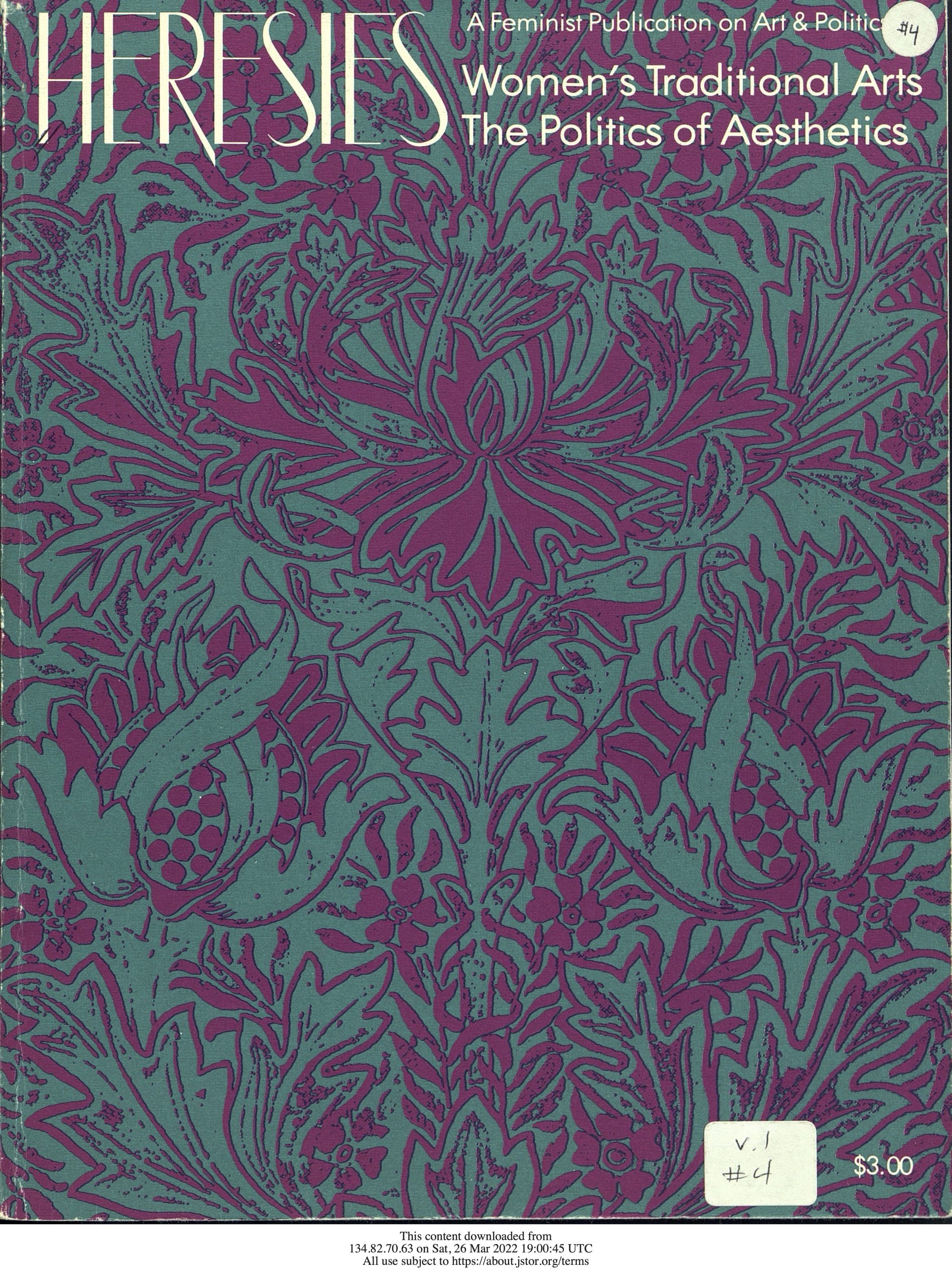Linda Nochlin
The feminine presence in the field of the decorative arts, more specifically, those related to textiles—weaving, embroidery, stitchery—is a time-honored one. See Women Artists, pp. 15-17. Indeed, women have continued to make significant contributions in this area through the nineteenth and twentieth centuries. For example, exhibits—rather conventional ones, to be sure—of lace, embroidery, tapestry and needle-work were prominent among the works illustrated in the official publication of Art and Handicraft in the Woman's Building of the World's Columbian Exposition in Chicago in 1893. Later, the leading weavers and tapestry makers at the Bauhaus—Anni Albers, Ruth Consemüller, Gunta Stölzl, Otti Berger, Benita Koch-Otte—were women. Although women may have traditionally been involved in handweaving and art weaving, this is by no means true as far as industrial or mass-production of cloth is concerned. Nevertheless, this traditional relation, or perhaps relegation, of women to the decorative arts was complicated by a variety of social and economic as well as ideological factors at the turn of this century. One complicating factor was the ambiguous status and prestige accorded to the decorative arts themselves, especially in relation to the so-called high arts of painting and sculpture. Another was the complex relationship of the decorative arts to the evolution of abstract painting and the subsequent development of an abstruse mystique to differentiate the latter from the former. Still another factor was the social, political and moral implications associated with the promotion of the handicrafts and with education in design, especially in Great Britain during the latter part of the nineteenth century.
Have women simply been shunted off into the so-called minor or decorative arts because these were considered less demanding and were certainly less prestigious? It is undeniable that English women were admitted to the Schools of Design, both the Branch Schools and their own Female School in London, long before they were admitted, in any significant numbers, to the teaching facilities of the Royal Academy. The ranks of these schools were swelled not merely by the working-class girls for whom this sort of training, aimed primarily at industrial design, was originally intended, but by vast crowds of impoverished young ladies who were in desperate straits trying to find employment in the arts, primarily as governesses. Q. Bell, The Schools of Design, London, 1963, pp. 135-137. Even earlier, in France, Mme. Frere de Montyon, a student of Restout's, had founded the Ecole Gratuite de Dessin pour les Jeunes Personnes, a school established in 1805 to help penniless young women become self-supporting, an enterprise perhaps intended as much to aid public morals as to encourage artistic ability. The Ecole Gratuite de Dessin was brought under government jurisdiction in 1810. Rosa Bonheur's father took over the directorship in 1848, and his daughter, the following year. The school was headed by Mlle. Nelly Marandon de Montyel after 1860. I am grateful to Professor Albert Boime for much of this information.
The democratizing effort to extend knowledge of the applied arts to the lower classes—and to women—was carried further in subsequent attempts to break down completely the barriers between high art and the decorative arts. The attempt reached a climax in Great Britain during the late nineteenth century with the program of social transformation proposed by John Ruskin and, especially, by William Morris. Interestingly enough, women seem to have served little more than a purely inspirational function for Morris and his followers, although both Janey and May Morris produced embroidery for the cause of arts and crafts. Women in late nineteenth-century England certainly made contributions to porcelain painting textiles, embroidery, and, often anonymously, to patchwork and other forms of stitchery, and of course Kate Greenaway was active as an illustrator and tile-designer, influencing Gauguin and many other painters. Nevertheless, women as a group were not prominent in the English Arts and Crafts Movement. In Scotland, however two unusually gifted and productive sisters, Frances Macdonald (1874-1921) and Margaret Macdonald (1865-1933) made major contributions in design. Margaret later married the innovative architect and designer Charles Rennie Mackintosh, and as members of his circle both sisters created imaginative curvilinear designs for architectural ornaments, metalwork, embroideries and stained glass, as well as watercolors that often hover on the brink of abstraction.
Although the effort to overthrow the hegemony of "high art" by merging it with the "minor" arts, an effort that has characterized one current of vanguard ideology from Synthetism to Constructivism, is by no means a feminine invention, the extent to which the decorative arts, especially those involving textiles, have played a role in the careers of advanced women artists is striking. Yet even though their achievements in these realms are often brilliant, the fact that painters like Nataliia Goncharova, Alexandra Exter, Liubov Popova and Varvara Stepanova, Sophie Taeuber-Arp and Vanessa Bell, Marguerite Zorach and Sonia Delaunay were involved in textile design, weaving, tapestry making and costume design nevertheless has equivocal implications. On the one hand, for a woman artist to "return," as it were, to her traditional role in the minor arts, generally less conducive to fame and fortune than a career in painting or sculpture, can be viewed as a retrograde step. Yet from another vantage point, we can say that advanced women artists involved in the decorative arts in the early twentieth century were contributing to the most revolutionary directions—both social and aesthetic—of their times.
Marguerite Zorach may indeed have turned from painting to embroidering tapestries after the birth of her second child, when she "no longer had the hours of uninterrupted concentration that she re quired to work out her personal views on canvas," National Collection of Fine Arts, Marguerite Zorach: The Early Years, 1908-1920, 1973, p. 50. The artist was joined briefly in her tapestry work by her husband, William Zorach. and Sonia Delaunay may have moved from monumental Orphist canvases to fabric and dress design in order to support her husband and herself after the loss of her private income following the Russian Revolution. Nevertheless it is also true that Zorach's needlework, in many ways more original and interesting than her paintings, received more exposure and critical attention than her canvases during the 1920s and '30s, Ibid., p. 57. and that Delaunay had had considerable success in the applied arts before the loss of her income and continued to make some of her most original contributions in this area throughout her career. Certainly the experiences of Sophie Taeuber-Arp and Vanessa Bell in the decorative arts exerted a progressive influence on their "high art" creations. Taeuber-Arp, who began as a textile specialist and taught weaving and embroidery at the Arts and Crafts School in Zurich, may well have influenced her husband Jean Arp, in the direction of greater abstraction as a result of the embroidery and weaving they did together at the time of the First World War. Indeed, it was probably precisely because of her background in the decorative arts that Taeuber-Arp was one of the first artists to think of abstraction as a natural point of departure rather than the end of a long process of evolution from representation. See Taeuber-Arp bibliography in Women Artists. Vanessa Bell's participation from 1913 to 1919 in Roger Fry's Omega Workshops, for which she designed screens, textiles and mosaics, seems to have intensified her penchant for abstract colorism and bold surface treatment which had already been stimulated by contact with the Fauves and Cubists. See Bell bibliography in Women Artists.
In attempting to evaluate women artists' contributions to the decorative arts, much depends on one's attitude toward the relative importance of the "high" versus the "applied" arts. If we consider painting the ultimate form of aesthetic expression, then it will be a foregone conclusion that Sonia Delaunay made a sacrifice by neglecting her monumental abstract canvases to produce fabrics and fashions, while her husband, Robert Delaunay, was permitted to continue his calling as a painter and, perhaps even more important, as a theorist of abstract art. If, however, we take a less conventional view of what constitutes value in the avant-garde production of the twentieth century, we can see that women artists, by remaining faithful to their time-honored role as decorative artists, have advanced the cause of abstraction and, at the same time, spread its message beyond the walls of the studio, museum and gallery into the realm of daily life—a goal devoutly sought by artists—whether "high" or "applied," male or female—from the time of Ruskin and Morris to the Russian Revolution, the Bauhaus and afterwards.
From Ann Sutherland Harris and Linda Nochlin, Women Artists: 1550-1950. Reprinted by permission from the Los Angeles County Museum of Art and Alfred A. Knopf.
Linda Nochlin is Professor of Art History at Vassar College.

